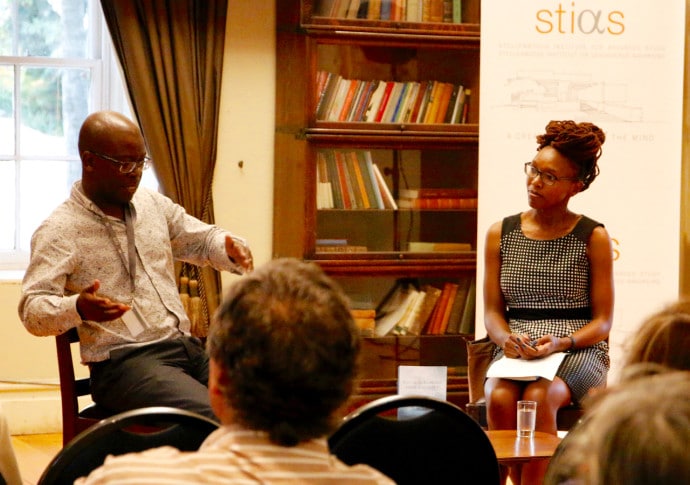“I see my writing as a vehicle to reintroduce many dialogues we still have to work through.”
“It is a historical novel but should be read as a novel. It would be found wanting as a history book. It uses a historical incident as a springboard to look at our evolution as a nation.”

Author and journalist Fred Khumalo was speaking at the launch of his novel Dancing the Death Drill held at STIAS. He was in conversation with Prof. Grace Musila from the English Department at Stellenbosch University. Both Khumalo and Musila are STIAS fellows and the novel was partly written while Khumalo was in residence at STIAS back in 2014.
“I am a twilight person – straddling two worlds – trying to bridge the gap between the fading oral storytelling tradition and the world in which everything is in the public domain,” he continued. “The oral tradition is dying – there are no more grandmothers telling stories. I’m hoping to challenge historians and other storytellers to delve deeply and make sure these stories live on.”
“I challenge those who can to bring these hidden stories into the public domain from where they can filter into the historical record,” he added. “I want to bring the Zulu oral tradition into formalistic English – ‘ZuEnglish’ – so to speak.”
Dancing the Death Drill retells the events surrounding the sinking of the SS Mendi 100 years ago in the English Channel during World War I in which 618 black South African troops drowned – one of the worst yet least known maritime disasters in UK waters in the 20th century.
“I first encountered the story of the Mendi in a song we used to sing as children,” said Khumalo. “It took a visit to France for me to realise, now as an adult that it had actually happened.”
“When I tried to do further research on it I found there was virtually no information – only one book.”
“I felt it was incumbent upon me to dignify the event with a novel. It’s about uncovering our hidden histories,” he added.
“The ship with 900 men aboard was crossing the English Channel during World War I when it was accidentally rammed by another boat. Some men were trapped in the hull, others tried to jump off but many couldn’t swim – it was a cold, dark early morning in the Northern Hemisphere Autumn – hence the high death rate.”
“Some of the men stood on the upper deck in formation and ‘danced the drill of death’ while the ship went down,” he added.
“According to the oral tradition the ship was torpedoed by the Germans but it was actually a horrible accident.”
In the novel Khumalo has used this incident as well as the Boer War to investigate the impact of these wars on Black South Africans – which has not been well documented to date.
“There were black women and children in the Concentration Camps during the Boer War – that is not often spoken about.”
He has also used this event to question why people agreed to help in a war that was not theirs and was about protecting an Empire that had recently introduced the brutal Native Land Act of 1913 which still has consequences in South Africa.
“An estimated 23 000 black soldiers were recruited during World War I. I believe they saw participation in the war as an opportunity to throw in their lot with the Empire and possibly convince them to rescind the Act,” he said. “It was, however, very naïve to believe they could twist the hand of the Empire.”
“There was also a financial incentive – the £3 per month salary was more than many earned at home.”
“They were also not armed – it was believed this would plant an undesirable seed that the white man was not invincible.”
“After the war they received no acknowledgements and no medals. They were not regarded as ‘proper’ soldiers even though their participation profoundly affected all aspects of their lives,” he continued.
‘Many had discovered their manhood in war and wanted to be treated like men when they returned home.”
In addition to the war theme, the book is also a thriller – the protagonist, who is the child of an Afrikaner and Mosotho who meet during the Boer War, is accused of murder and eventually stands trial in a French Court. It also involves more than one love story.
Music and art are also woven throughout the story. “It’s an attempt to humanise soldiers – to expose their vulnerability. I wanted to juxtapose art and music into a masculine, military novel. Music is part of everything we do – we sing when we are happy, when we are sad, when we are grieving. Music, and jazz in particular, are part of my life – the spectre of jazz has haunted me – I listen to music when I write – always.
“Our past deserves artistic interrogation – a chance to see things from different angles,” said Khumalo. “We need to break the walls between cultures through artistic expression.”
“The book is also available in a Zulu version – I’m still looking for a publisher – I think it’s important that it is told in that language. In fact in as many languages as possible,” he concluded.
See the event announcement here.
Words: Michelle Galloway, Part-time media officer at STIAS
Photograph: Christoff Pauw
